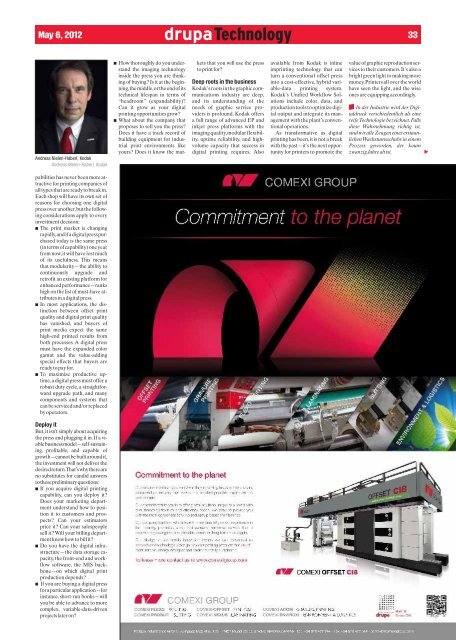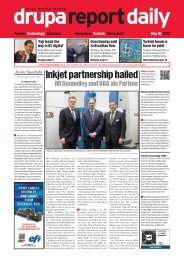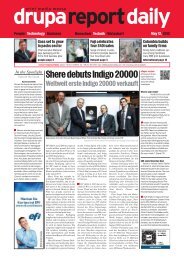drd 2012-05-06 - Drupa Report Daily
drd 2012-05-06 - Drupa Report Daily
drd 2012-05-06 - Drupa Report Daily
Sie wollen auch ein ePaper? Erhöhen Sie die Reichweite Ihrer Titel.
YUMPU macht aus Druck-PDFs automatisch weboptimierte ePaper, die Google liebt.
May 6, <strong>2012</strong> drupa Technology<br />
33<br />
Andreas Nielen-Haberl, Kodak<br />
Andreas Nielen-Haberl, Kodak<br />
■ How thoroughly do you understand<br />
the imaging technology<br />
inside the press you are thinking<br />
of buying? Is it at the beginning,<br />
the middle, or the end of its<br />
technical lifespan in terms of<br />
“headroom” (expandability)?<br />
Can it grow as your digital<br />
printing opportunities grow?<br />
■ What about the company that<br />
proposes to sell you the press?<br />
Does it have a track record of<br />
building equipment for industrial<br />
print environments like<br />
yours? Does it know the markets<br />
that you will use the press<br />
to print for?<br />
Deep roots in the business<br />
Kodak’s roots in the graphic communications<br />
industry are deep,<br />
and its understanding of the<br />
needs of graphic service providers<br />
is profound. Kodak offers<br />
a full range of advanced EP and<br />
inkjet press platforms with the<br />
imaging quality, modular flexibility,<br />
uptime reliability, and highvolume<br />
capacity that success in<br />
digital printing requires. Also<br />
available from Kodak is inline<br />
imprinting technology that can<br />
turn a conventional offset press<br />
into a cost-effective, hybrid variable-data<br />
printing system.<br />
Kodak’s Unified Workflow Solutions<br />
include color, data, and<br />
production tools to optimize digital<br />
output and integrate its management<br />
with the plant’s conventional<br />
operations.<br />
As transformative as digital<br />
printing has been, it is not a break<br />
with the past—it’s the next opportunity<br />
for printers to promote the<br />
value of graphic reproduction services<br />
to their customers. It’s also a<br />
bright green light to making more<br />
money. Printers all over the world<br />
have seen the light, and the wise<br />
ones are equipping accordingly.<br />
In der Industrie wird der Digitaldruck<br />
verschiedentlich als eine<br />
reife Technologie bezeichnet. Falls<br />
diese Wahrnehmung richtig ist,<br />
sind wir alle Zeugen eines erstaunlichen<br />
Wachstumsschubs in einem<br />
Prozess geworden, der kaum<br />
zwanzig Jahre alt ist.<br />
▶<br />
pabilities has never been more attractive<br />
for printing companies of<br />
all types that are ready to break in.<br />
Each shop will have its own set of<br />
reasons for choosing one digital<br />
press over another, but the following<br />
considerations apply to every<br />
investment decision:<br />
■ The print market is changing<br />
rapidly, and if a digital press purchased<br />
today is the same press<br />
(in terms of capability) one year<br />
from now, it will have lost much<br />
of its usefulness. This means<br />
that modularity—the ability to<br />
continuously upgrade and<br />
retrofit an existing platform for<br />
enhanced performance—ranks<br />
high on the list of must-have attributes<br />
in a digital press.<br />
■ In most applications, the distinction<br />
between offset print<br />
quality and digital print quality<br />
has vanished, and buyers of<br />
print media expect the same<br />
high-end printed results from<br />
both processes. A digital press<br />
must have the expanded color<br />
gamut and the value-adding<br />
special effects that buyers are<br />
ready to pay for.<br />
■ To maximize productive uptime,<br />
a digital press must offer a<br />
robust duty cycle, a straightforward<br />
upgrade path, and many<br />
components and systems that<br />
can be serviced and/or replaced<br />
by operators.<br />
Deploy it<br />
But, it isn’t simply about acquiring<br />
the press and plugging it in. If a viable<br />
business model—self-sustaining,<br />
profitable, and capable of<br />
growth—cannot be built around it,<br />
the investment will not deliver the<br />
desired return. That’s why there are<br />
no substitutes for candid answers<br />
to these preliminary questions:<br />
■ If you acquire digital printing<br />
capability, can you deploy it?<br />
Does your marketing department<br />
understand how to position<br />
it to customers and prospects?<br />
Can your estimators<br />
price it? Can your salespeople<br />
sell it? Will your billing department<br />
know how to bill it?<br />
■ Do you have the digital infrastructure—the<br />
data storage capacity,<br />
the front-end and workflow<br />
software, the MIS backbone—on<br />
which digital print<br />
production depends?<br />
■ If you are buying a digital press<br />
for a particular application—for<br />
instance, short-run books—will<br />
you be able to advance to more<br />
complex, variable-data-driven<br />
projects later on?






